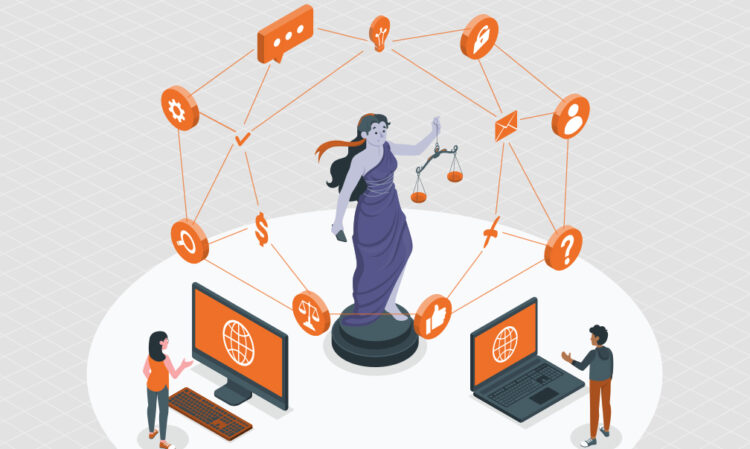In an increasingly complex and interconnected world, the pursuit of fairness, equity, and access to legal rights is paramount. Justice innovation stands at the forefront of this endeavor, harnessing the power of technology, design thinking, and systemic reform to fundamentally reshape and enhance the administration of justice. Far from merely digitizing old processes, this movement is about creating new realities of fairness, democratizing legal access, increasing efficiency, and building more equitable judicial systems for all. Understanding the driving forces, the diverse applications, and the profound impact of justice innovation is crucial for legal professionals, policymakers, technologists, and anyone invested in a more just and accessible society.
The Imperative for Transformation

For centuries, legal systems have been characterized by formality, complexity, and often, significant barriers to access. While tradition provides stability, the rapid pace of societal change and technological advancement has highlighted the urgent need for a more responsive, efficient, and user-centric approach to justice.
A. The Evolution of Justice Delivery
From cumbersome paper-based systems to digital platforms and AI-driven solutions, the methods of justice delivery are undergoing a profound metamorphosis.
- Paper-Based Bureaucracy: Historically, legal systems were heavily reliant on physical documents, manual record-keeping, and in-person processes, leading to delays, high costs, and limited accessibility, especially for those in remote areas.
- Early Digitization: The initial steps involved digitizing records and introducing basic electronic filing systems, primarily aimed at internal efficiency rather than public access or systemic reform.
- The Internet and Online Access: The advent of the internet enabled greater access to legal information, online self-help resources, and initial steps toward online dispute resolution (ODR). This began to empower individuals with more legal knowledge.
- Mobile and Cloud Solutions: The proliferation of smartphones and cloud computing has made legal services and information more accessible on the go, allowing for virtual court appearances, mobile legal aid apps, and cloud-based case management.
- Data Analytics and AI Integration: The current era is defined by the strategic application of data science and Artificial Intelligence. AI is being used for predictive analytics (e.g., predicting case outcomes), automating legal research, generating legal documents, and even identifying biases within the system.
- Focus on User Experience (UX): Recognizing that legal systems serve people, there’s a growing emphasis on human-centered design, making legal processes more intuitive, understandable, and less intimidating for the public.
B. Why Justice Innovation Is Non-Negotiable
The motivations behind this transformative push are rooted in fundamental societal needs and the capabilities offered by modern technology.
- Access to Justice Crisis: Millions worldwide, particularly marginalized and low-income individuals, lack affordable access to legal advice and representation. Innovation seeks to bridge this gaping access gap.
- Efficiency and Cost Reduction: Traditional legal processes are often slow, resource-intensive, and expensive. Innovation aims to streamline workflows, reduce administrative burdens, and lower overall costs for both institutions and users.
- Enhanced Fairness and Equity: Technology can be a powerful tool to identify and mitigate biases within legal systems, ensure consistent application of law, and provide greater transparency and accountability.
- Increased Transparency: Digital systems can provide greater visibility into legal processes, making them more understandable and fostering public trust.
- Meeting User Expectations: Digital natives expect seamless, user-friendly digital interactions in all aspects of their lives, including legal services. Justice systems must adapt to these expectations.
- Responding to New Challenges: Emerging issues like cybercrime, digital rights, and data privacy require innovative legal frameworks and delivery mechanisms.
The Pillars of Justice Innovation
Justice innovation is a broad field, encompassing a range of applications designed to improve various facets of the legal system, from pre-emptive measures to post-resolution support.
A. Legal Technology Solutions
Leveraging software and digital platforms to streamline legal processes and enhance access.
- Online Dispute Resolution (ODR) Platforms:A. Facilitating Resolution: Platforms that allow parties to resolve disputes (e.g., consumer complaints, small claims, family matters) online, often without the need for in-person court appearances. This increases convenience and reduces court backlogs.B. Mediation and Arbitration Tools: Incorporating AI-powered negotiation assistants or virtual mediation rooms to guide parties towards amicable solutions.
C. Global Reach: ODR platforms can facilitate cross-border dispute resolution more efficiently.
- Legal Aid Apps and Portals: Mobile applications and web portals that provide free or low-cost legal information, self-help guides, document templates, and directories of legal aid services to underserved populations.
- Automated Document Generation: Software that uses templates and user input to automatically generate legal documents (e.g., contracts, wills, court forms), reducing legal fees and increasing accessibility for basic legal needs.
- E-discovery Tools: Advanced software that uses AI to rapidly analyze vast amounts of electronic data (emails, documents) for relevant information in litigation, significantly reducing the time and cost of discovery.
- Court Management Systems: Digital platforms for managing court dockets, scheduling hearings, electronic filing of documents, and tracking case progress, improving administrative efficiency for courts.
B. Artificial Intelligence (AI) in Justice
AI is moving beyond simple automation to provide sophisticated analytical capabilities and insights within the legal sphere.
- Predictive Analytics for Case Outcomes: AI models that analyze historical case data to predict potential outcomes, helping lawyers assess risk, advise clients, and inform settlement strategies.
- Legal Research Automation: AI-powered tools that can quickly scan vast legal databases, identify relevant case law, statutes, and articles, significantly reducing the time required for legal research.
- Contract Review and Analysis: AI that can review contracts for specific clauses, identify inconsistencies, or flag potential risks, enhancing efficiency and accuracy in legal due diligence.
- Bias Detection: AI can be used to analyze court data (e.g., sentencing records) to identify potential patterns of bias or disparities in legal outcomes, providing insights for systemic reform.
- Judicial Decision Support (Controversial): While still highly debated, some AI tools aim to assist judges by providing data-driven insights, though human judgment remains paramount.
- Legal Chatbots: AI-powered chatbots that can answer basic legal questions, guide users through simple legal processes, or direct them to appropriate resources.
C. Data-Driven Insights and Systemic Reform
Leveraging data to understand systemic issues and drive evidence-based policy changes.
- Performance Metrics for Courts: Using data analytics to track court efficiency, backlogs, case resolution times, and resource allocation to identify areas for improvement.
- Understanding Disparities: Analyzing judicial data to identify and quantify racial, socioeconomic, or gender disparities in arrests, sentencing, or access to legal services.
- Policy Evaluation: Using data to assess the effectiveness of new legal policies or reform initiatives, providing evidence for refinement or scaling.
- Resource Allocation: Data-driven insights can help governments and legal aid organizations allocate resources more effectively to areas with the greatest need.
D. Human-Centered Design and Access to Justice (A2J)
Shifting the focus to the end-user experience to make justice systems more accessible and less intimidating.
- Simplified Language: Reforming legal documents and court forms to use plain language, making them understandable to the general public, not just legal professionals.
- User Journey Mapping: Understanding the entire process a person goes through when interacting with the legal system to identify pain points and opportunities for simplification.
- Physical Space Redesign: Reimagining courtrooms and legal aid offices to be less intimidating, more welcoming, and user-friendly, incorporating comfortable waiting areas and clear signage.
- Legal Design Thinking: Applying design thinking methodologies to legal problems, focusing on empathy, ideation, prototyping, and testing solutions with end-users.
- Pro Bono Innovation: Developing innovative models for delivering pro bono legal services more efficiently and broadly, leveraging technology and volunteer networks.
E. Blockchain for Legal Applications (Emerging)
While nascent, blockchain technology holds promise for enhancing trust, transparency, and efficiency in certain legal contexts.
- Smart Contracts: Self-executing contracts written into code on a blockchain, potentially automating agreements and reducing the need for intermediaries in certain transactions.
- Digital Notarization: Using blockchain to create immutable, verifiable records of document authenticity and timestamps.
- Intellectual Property Protection: Recording intellectual property rights on a blockchain to provide immutable proof of creation and ownership.
- Decentralized Autonomous Organizations (DAOs) and Governance: Exploring how DAOs could create new, transparent models for collective decision-making and governance, with potential applications in legal entity management.
The Profound Impact in Society for Fairness

Justice innovation isn’t just about incremental improvements; it’s about fundamentally reshaping societal structures to deliver more equitable, efficient, and transparent justice for all.
A. Democratizing Access to Legal Services
The most significant impact is the potential to bridge the “access to justice” gap, empowering marginalized communities.
- Empowering Self-Represented Litigants: Providing user-friendly tools and information allows individuals to navigate legal processes (e.g., small claims, family law) without expensive legal representation.
- Reaching Underserved Populations: Mobile legal aid apps and online portals can deliver legal information and services to remote areas or communities with limited physical access to legal assistance.
- Reducing Costs for Users: Automation, ODR, and self-help tools reduce the financial burden of legal services, making justice more affordable for average citizens.
- Increasing Legal Literacy: Access to understandable legal information empowers individuals to better understand their rights and responsibilities.
B. Enhancing Efficiency and Reducing Backlogs
Innovation can streamline judicial processes, benefiting courts and citizens alike.
- Faster Case Resolution: ODR platforms, e-filing, and automated legal research tools accelerate the pace of legal proceedings, reducing court backlogs and ensuring timely justice.
- Resource Optimization: Automation of routine tasks allows legal professionals and court staff to focus on more complex, high-value work, optimizing resource allocation.
- Reduced Administrative Burden: Digital systems simplify record-keeping, scheduling, and communication, making the administrative side of justice more efficient.
- Improved Data Flow: Seamless data flow between legal entities (police, courts, corrections, legal aid) can improve coordination and efficiency across the entire justice system.
C. Fostering Fairness, Transparency, and Accountability
Technology can be a powerful tool for promoting equity and trust in the legal system.
- Identifying Bias: Data analytics and AI can uncover patterns of systemic bias (e.g., racial bias in sentencing), providing critical information for targeted interventions and reforms.
- Increased Transparency: Online public records, accessible court documents, and clear process flows foster greater transparency, allowing for public oversight and increasing trust in the system.
- Consistent Application of Law: Data-driven insights can help ensure more consistent application of legal standards across similar cases.
- Accountability: Greater transparency and data insights can hold legal institutions and professionals more accountable for their decisions and performance.
D. Preparing for Future Legal Challenges
Innovation helps legal systems adapt to the complexities of a rapidly evolving world.
- Cybercrime and Digital Rights: Developing new legal tools and expertise to address emerging challenges like cybercrime, data privacy violations, and intellectual property in the digital age.
- Global Legal Cooperation: Digital platforms facilitate cross-border legal cooperation and information sharing for international crime and dispute resolution.
- Ethical AI in Law: Pioneering ethical frameworks and best practices for the responsible integration of AI into legal decision-making processes.
Challenges and Considerations
While the promise of justice innovation is profound, its implementation is not without significant challenges that demand careful consideration and proactive mitigation strategies.
A. Ethical and Societal Dilemmas
The integration of advanced technology into legal systems raises complex ethical questions.
- Algorithmic Bias: AI systems trained on biased historical data can perpetuate or even amplify existing societal biases (e.g., racial, socioeconomic) in areas like predictive policing, sentencing recommendations, or risk assessments. Ensuring fairness and preventing discrimination is paramount.
- Transparency and Explainability of AI: The “black box” nature of some AI algorithms makes it difficult to understand how decisions are reached, raising concerns about accountability and due process, especially in contexts that affect fundamental rights.
- Privacy and Data Security: Legal data is highly sensitive. The extensive collection and use of personal data for AI and analytics raise significant concerns about privacy, data breaches, and potential misuse of information.
- Human Oversight and Accountability: Determining the appropriate balance between human judgment and AI assistance, and ensuring human accountability for AI-driven decisions, is a critical challenge.
- Digital Divide and Equity of Access: While innovation aims to bridge the access gap, if not implemented thoughtfully, it could inadvertently create new forms of exclusion for those without digital literacy, internet access, or necessary devices.
B. Implementation and Adoption Hurdles
Transforming deeply entrenched legal systems faces significant practical obstacles.
- Resistance to Change: Legal professionals, court staff, and even the public may resist new technologies and processes due to ingrained traditions, fear of the unknown, or perceived threats to their roles.
- High Costs of Development and Integration: Developing and implementing sophisticated legal tech solutions, especially for large public institutions, can be incredibly expensive and require significant upfront investment.
- Interoperability: Ensuring that new digital systems can seamlessly integrate with legacy systems and across different legal entities (courts, police, prisons) is a major technical challenge.
- Lack of Digital Literacy: Many legal professionals and members of the public may lack the necessary digital literacy skills to effectively use new legal tech tools.
- Data Quality and Availability: For AI and analytics to be effective, high-quality, comprehensive, and consistent data is essential, which can be a significant challenge in traditional legal systems with fragmented data.
C. Legal and Regulatory Frameworks
The rapid pace of innovation often outstrips the development of appropriate legal and ethical guidelines.
- Outdated Laws: Many existing laws and regulations were designed for an analog world and may not adequately address the complexities of digital evidence, online contracts, or AI’s role in legal processes.
- Regulatory Uncertainty: The lack of clear legal definitions for new technologies (e.g., smart contracts, AI-driven legal advice) creates uncertainty for developers and users.
- Jurisdictional Complexity: Laws vary widely by jurisdiction, making it challenging to develop universally applicable innovative solutions.
- Consumer Protection: Ensuring adequate consumer protection for individuals using new legal tech services or engaging in online dispute resolution.
Conclusion
Justice innovation is not a luxury but an absolute necessity, serving as the crucible for shaping fairness in the 21st century. By strategically leveraging technology, embracing human-centered design, and committing to systemic reform, legal systems can become more accessible, efficient, equitable, and transparent for everyone. From online dispute resolution and AI-powered legal research to data-driven insights and blockchain applications, the tools for transformation are at our disposal.
While the path is fraught with ethical dilemmas, implementation challenges, and the need for adaptable regulations, the potential rewards – democratized access to justice, reduced costs, enhanced fairness, and stronger public trust – are immense. For those dedicated to building a society where justice is not merely an ideal but a tangible reality for all, embracing and championing justice innovation is not just a professional imperative; it is a profound moral commitment to crafting a more just and equitable tomorrow. The legal system is evolving, and innovation is its guiding principle.













